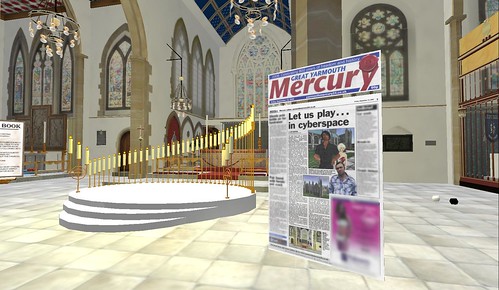The next big conference and expo for all things virtual world is happening in London in 2 weeks time. Its the second year of the Virtual Worlds Forum Europe and a few of your favourite eightbars will be in attendance, aswell as a more formal IBM presence. (IBM is a sponsor).
Rob and I will be around at the event as will Holly and Kevin. Lots of brit metarati.

It is particularly interesting for us as many of you know Rob and I and Roo before work for the global CIO office. Our director of technology and innovation Luba Cherbakov is flying over to present at this event. As you know we do a lot of work with enterpise virtual worlds and how we can use that inside our company and also help others understand this growing market.
This year there is a mixture of expo and congress. So if you need to come have a chat Rob and I will more than likely be around the IBM stand.
Of particular interest is to me is the lead sponsor Unity3d as you would have seen from some of the previous posts this has been an area of exploration that Rob has been diving inot recently (along with OpenSim), in particular with the pub/sub messaging extending what is already done here at Hursley.
Last years event was very enjoyable. The mix of actual game based firms and enterprise firms with a certain creative twist is very London and very Europe.
So come and see us at the expo or at the after show parties.
Category Archives: Hursley
We are on TV… again. This time Sky
The recent hursley 50th has yielded this great bit of footage.
The whole package is great, but 4 mins in, yours truly rocking the virtual world
Yes I do quote(with attribution) the famous Warcraft is the new golf phrase. 🙂
I also seem to have become the lead story on the event. Fancy that.
Hursley 50th celebrations with added metaverse
This week has seen the official part of the IBM Hursley 50th anniversary celebrations. To mark the occasion we have had 3 days of visitors to little country estate in Hampshire, with a mix of presentations and expo’s of all the things that are done here.
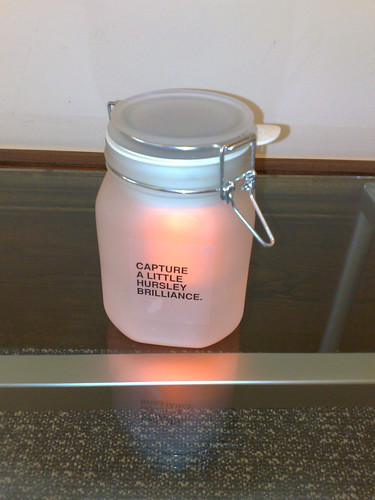
We had a visit from John Denham, Secretary of State for innovation, university and skills which involved a tour around the entire site expo.
We then had a day of customer visitors, featuring some presentations, expo walk arounds and presentations in the new Innovation Centre here in Hursley (which needs a post of its own!)
The next day saw members of the press, including TV crews come and do some interviews and see the show.
That ended the visits but we then ran the expo for the 3,000 employees on site to come and talk.
The really cool thing for us here at eightbar was our position in both the expo and on the schedule of speakers. Rob had the stand up and running with lots of people drawn to and interested in the nice innovation award, unity3d, metaverse, opensim etc. I helped out there when I could, but I had lots of 1:1 interviews and conversations to do as well as presenting my usual Virtual Worlds pitch.
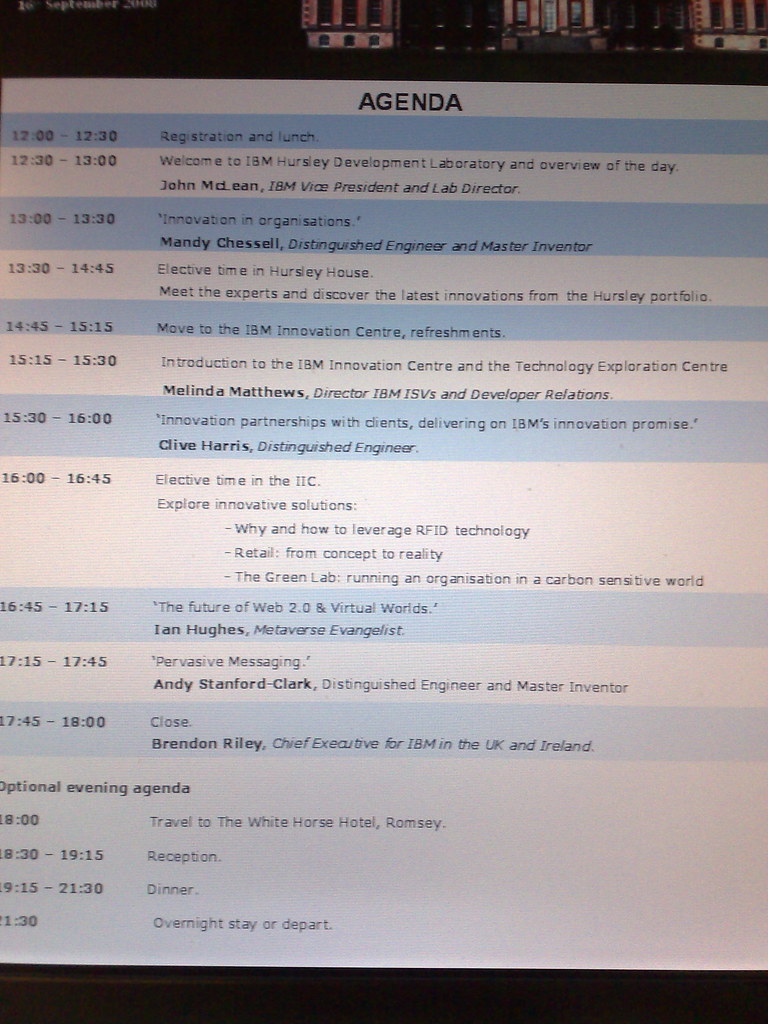
So there I was nestled admist the Lab Director, Chief Executive and Distinguished Engineers spreading the word about eightbar and metaverses.
It was also important as it belnds with what Hursley already does. Hursley is the home of messaging and of transaction processing. As you saw from the recent post we are very much implementing MQ pub/sub messaging across our CIO projects in various virtual worlds to achieve a different level of interoperability. Gordy and I also have a patent filed on transaction processing. Bear in mind CICS (which runs many of the transactions many of you make daily in banking) is 30 40 years old. So CICS still has relevance in dealing with complex transactions in a virtual world too.
The food was pretty good to at the events.
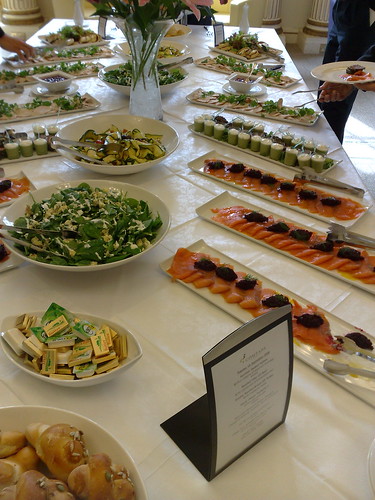
I include this photo becuase a fellow IBMer said “I suppose that will end up on the internet?” erm… yes 🙂
Also we dont just turn up at these things, lots of extra effort goes into it. Rob’s posters are a prime example, representing all of Emerging Tech here in Hursley.
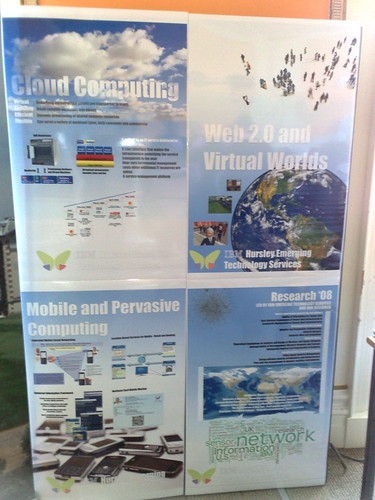
The mobile and pervasive piece bottom left was not clipart, but planned by rob in a photo shoot having collected lots of mobiles from us and from Dave’s office. Planned, photographed, built into a poster, sent for printing and mounting, put up and then explained for 4 days by Rob, Bharat(pervasive) and Jules(cloud).
So I wonder what the new kid on the block that mucles its way onto the agenda will be in 50 years time?
Web 2.0 to OpenSim made easy (JSON support added)
I’ve been tracking the progress of the OpenSim project for quite some time now and gradually delving deeper into the midst of this little open-source wonder.
For those of you who haven’t come across OpenSim, or have heard of it but haven’t investigated in too much detail; OpenSim is a Virtual Worlds platform built from the ground up which uses the Second Life protocol. Initially OpenSim has set out to emulate the current function of the Second Life servers. This means that you use the Second Life client to log onto an OpenSim server.
OpenSim has been built in a modular fashion, meaning that particular modules can be swapped in and out depending on the purpose of the Virtual World you wish to run. At the moment the modules are limited to things like… support for different databases, physics engines, scripting engines etc.
In the future I expect to see a whole raft of new modules ranging from the important but slightly mundane, authentication e.g. LDAP, OpenID etc. to plugins allowing different client types e.g. Flash, Unity etc. and modules for payment systems etc.
At the moment OpenSim is still in alpha, with stability a high priority. Already though it is becoming well fleshed out with building, avatar customization the ability to connect multiple sims (islands) together and a healthy base of scripting available enabling the majority of existing LSL scripts to run and also allowing c# and other languages to be used.
In addition to the LSL scripting ported from Second Life there are extra API calls that can be made that enable function such as loading images from the web directly onto objects in world. There is also a scripting API that lets you format text and images on objects.
As I have become more involved in OpenSim and got to learn how it works a bit more I thought it time to start contributing something towards the codebase. A long time ago in Second Life I created a translation device that listened to your conversation and sent the text out to Google to be translated, it then read out the translation in world.
There are many other services in Second Life that use this pattern of utilizing services around the Web. The LSL scripting language however is not good at handling the formats that most Web 2.0 APIs and services speak. In fact may SL gadgets and devices rely on custom web server scripts to speak to the outside service and cut down the data drastically before its passed back into SL where the gadget uses it. This is a major pain in the ass as any SL gadget creator will tell you.
One of the most common formats used by Web 2.0 service APIs (Google,Flickr, Yahoo etc.) is called JSON (or javascript object notation). JSON is a simple way of describing objects, however it can come in many shapes and sizes making it almost possible to consume directly in SL or OpenSim.
For that reason my first contribution to the OpenSim project is to implement a scripting function called osParseJSON, which should hopefully open the flood gates for people who want to make the most of the Web 2.0 services they use every day and get that data into OpenSim.
For now I’ve written a simple example, that uses Googles translation API. The example lets you translate between 23 different languages.
Hometown serendipity St Nicholas Church in Second Life
Today I received a call from my dad, he had seen a news article in my hometown newspaper the fabled Gt Yarmouth Mercury. Great Yarmouth (for those not of a UK disposition) is far on the east coast of england, the round bit that stick out and is just north of the most easterly point in the isles. Now Dad has just taken to the interwebs with a new computer and has started to get to grips with all this stuff. The news article in the local paper was about a build in Second Life of the iconic and historically significant building in St Nicholas’s Church.
I decided to pop along and have a look, and I have to say that I really liked what I saw. Obviously mirror world builds are a significant part of any virtual world experience. To see it break in the press back home stating “Second Life became very well known at the end of 2006 when major companies took an interest” (ahem…. I wonder who that was then 🙂 go eightbar)
Anyway, I popped along, took these photos and was lucky enough to bump into the creator Sid Corleone and have a chat on the roof of the church (nearly a cathedral in size). It was interesting as Sid was building this to generate funds for the real building, but not from a strong religious conviction, but a historical and architectural one. Sid also told me of some future plans around the area, something I was more than happy to help with. Great Yarmouth has, for instance, the original Nelson’s Column. I suggested that he reminds the locals he is trying to help that a “minor celebrity” metaverse evangelist was born and bred in the area.
To add to the serendipity of the moment, Sid’s surname is that of the godfather. In ActiveWorlds i tended to use the godfather AV and in v-side I have a very nice godfather shirt I wear. Tenuous, but relevant and memorable connections I feel.
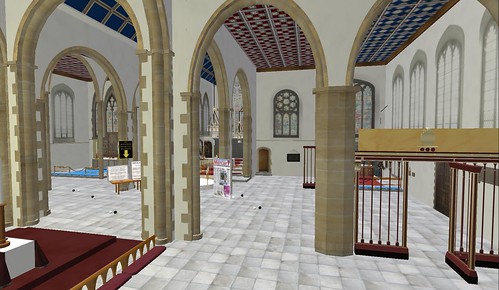
Here is one of the interior shots, Sid is still working, but has opened to show it off.
Sid also has put a copy of the news article that led me there in the first place in the church
Yes that is an evangelist in the pulpit
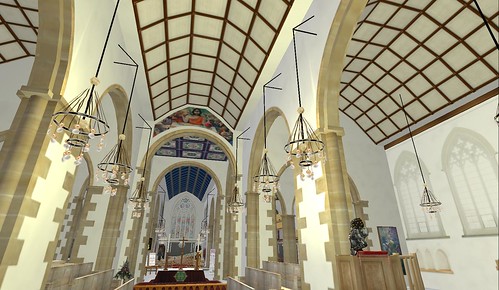
Sid has used lots of real world photos to texture the environment. Here is the arch over the door featuring the heraldic crest of Great Yarmouth
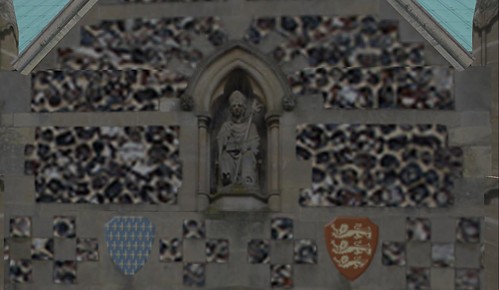
So where is it? I hear you ask. It’s here on Rosslyn go and take a look and welcome Sid to the metarati fold.
BTW if anyone wants to add epredator in as a notable resident on wikipedia please do 😉
Moving cubes from world to world
Today led to a rather exciting development. Since the original experiments with Second Life many of us from Hursley have wanted to apply the elements of pub/sub messaging that Hursley is known for to the transport of events from various virtual worlds.
Rob augmented his very cool Unity3d server worlds with the ability to consumer published messages on one of our many message brokers. This means any client that is subscribed to a particular message on the hub can take action. Having this in place meant we were able to do what was in this video.
Creating a cube in Second Life, publishes a message to the wider message queue. Several Unity3d clients subscribe to that in various ways and also create a cube.
This is interworld operability at a very different level to the import/export approach. Event brokers of this nature are the way we deliver point by point score data at sub second response times to web scoreboards for things like Wimbledon.
Publishing and subscribing to various messages and topics opens up a whole host of interworld communications that can occur. It still needs a client to understand how to recieve the messages but the beauty of pub/sub is that it can be push related or pull.
I thought I would put this video up and show what we were up to as I told a number of people about the plans we had at VW08 in LA.
So interoperability in virtual worlds from Hursley the home of messaging middleware.
Quick tour of the LA VW2008 expo floor
Earlier in the year in New York I took a dash around video of the expo floor. Now we are here in LA doing the next one I thought I would do the same thing to compare and contrast. 41+ exhibitors this time. Look out for some metarati faces you may know.
Navigating the web in a different way – Ubiquity
Thanks to Steve Hughes (fellow IBMer no relation) for pinging this url to Mozilla Labs Ubiquity This features a simple, yet very well executed set of ideas that alters how people will use the web. It is very early prototype, but its a personal mashup tool. Its task based, so as you start to do something, browser email etc, it acts as a helper gathering services from the web that you need for the task you are completing. e.g. sending an address to a friend, but also wanting to include a map.
Each of the things shown in the video demonstration indicate something that we probably have all done at some time or other, but that involve a lot of cutting and pasting, or page swapping to collate information. I know I personally find it annoying swapping around, writing a blog post, but cut and pasting in embed code from places like Flickr, when my brain is saying just put photo a. in here.
All the disparate systems all have services now that can be called upon. It would appear ubiquity is helping us, as people be the collator of those services. Its a great idea and I suspect we will seem more of this sort of thing. I already find Google desktop (just find the document on my machine for me will you please) essential, this would appear to be even more so as it evolves.
You can also see that there is now scope for some more AI innovation to be applied on top. Having an intelligent agent with a ubiquity style helper to pull web services together is going to be really useful.
I can also see how this can be applied not just to the 2d web services that the demo shows but to the wider metaverse services as they become more exposed. I am very impressed so far and look forward to seeing this develop.
2D to 3D but with more Wow factor.
Ian has previously covered software and methods for taking 2d images to 3d models here on Eightbar. Michael Ackerbauer here at IBM just brought this research from Volker Blanz and Thomas Vetter to my attention. I think you’ll agree it’s pretty awesome. Now just to find out where I can get my hands on it…
There is no Spoon – A taste of my own medicine
Today I noticed @ansi on the twitter stream mention this (very long) article at strategy-business.com on the neuroscience of leadership. It is based on the merging of some of the sciences and the ability to understand how psychology and chemical changes in the human brain drive behaviour.
This article caused me to stop and think about how I do things, why things have worked out the way they have. In some ways its a taste of my own medicine, the things I try and get across to people, in particular as a metaverse evangelist, but do not have the scientific backing just gut instinct to work with. So to quote The Matrix – “there is no spoon”.
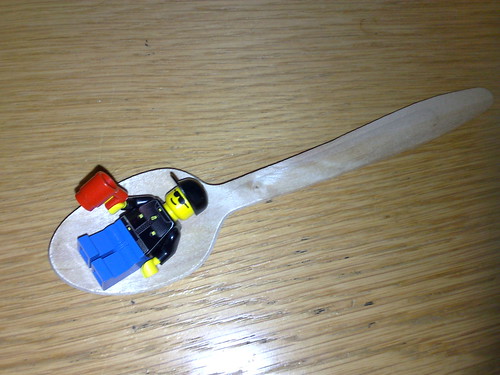
One of the most interesting points, that gave me an “oh I try and do that” moment was this statement.
“For insights to be useful, they need to be generated from within, not given to individuals as conclusions. This is true for several reasons. First, people will experience the adrenaline-like rush of insight only if they go through the process of making connections themselves. The moment of insight is well known to be a positive and energizing experience. This rush of energy may be central to facilitating change: It helps fight against the internal (and external) forces trying to keep change from occurring, including the fear response of the amygdala”
“When people solve a problem themselves, the brain releases a rush of neurotransmitters like adrenaline. This phenomenon provides a scientific basis for some of the practices of leadership coaching. Rather than lecturing and providing solutions, effective coaches ask pertinent questions and support their clients in working out solutions on their own.”
Insights, discovery, making an idea real to oneself produces a very different and positive chemical response in the brain. This is presumably why I often say I try and make things personal to people before the “business case” unless of course the “business case” or logic is the thing that will generate insight. This lets people feel why the concept would be useful for them, generating insight and synthesis making them feel good and able to explore the possibilities then based on their own mental model.
Another part of what the article states is that focus on an area or skill makes peoples mental models locked in more to that way of doing things. This stands to reason, but is good to see documented in this context.
“Attention continually reshapes the patterns of the brain. Among the implications: People who practice a specialty every day literally think differently, through different sets of connections, than do people who don’t practice the specialty. In business, professionals in different functions — finance, operations, legal, research and development, marketing, design, and human resources — have physiological differences that prevent them from seeing the world the same way.”
The implications of knowing or feeling the ideas in this article can be far reaching. Much of this requires, as they indicate, and ability to observe ones own motivations and patterns. Organisms strive for equilibrium apparently, that bubbles up into collections of organisms, corporations. I think though we have a fair set of people in the circles I move in whos equilibrium state is actually one of change and of new ideas, who instincitvely do things the way that this article suggests might work. If more people did it, I am guessing we would be even more effective?
So check out the full article, its very interesting, and try a bit of “self-directed neuroplasticity”
Thus endeth the pop science 🙂

